1. Volcano Anatomy and Explosivity
A volcano is a location where molten rock flows out, or erupts, onto Earth’s surface as lava. Magma is the name for molten rock under the Earth’s surface and lava is the name for molten rock on the Earth’s surface. Volcanic eruptions can happen on land or underwater. Some volcanic eruptions flow from mountains, such as the eruption of Mt. St. Helen’s in Washington State (Figure 1C.1.1, left) but others do not. Fissure eruptions (Figure 1C.1.1, right) are volcanic eruptions flowing from long cracks in the Earth such as the eruption along the Kamoamoa fissure on the flank of Kilauea in Hawaii.
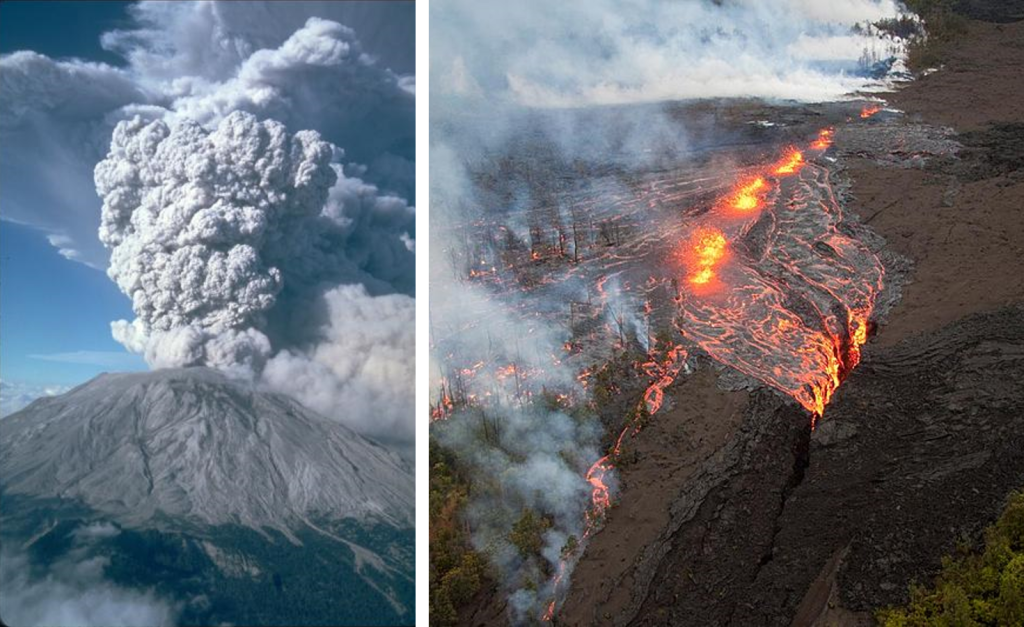
1.1 The Parts of a Volcano
The main parts of a volcano are shown in Figure 1C.1.2. The magma chamber sits deep in the Earth and is the large repository of molten rock. When volcanoes erupt, magma moves upward from the magma chamber, through conduits (the plumbing network inside the volcano) and up to the vents. The vents are the openings at the Earth’s surface through which the magma and gases escape. There is a central vent, which is the main opening at the top of the volcano, but volcanoes can also have many smaller side vents from which flank eruptions occur. A crater is the bowl-shaped depression surrounding the vent.
With continued eruptions, volcanic material accumulates around the vent forming a volcanic mountain. The accumulated material might consist of layers of solidified lava flows, fragments of volcanic debris that were ejected explosively from the volcano (the general term for this ejected material is pyroclastic material), or a combination of both.
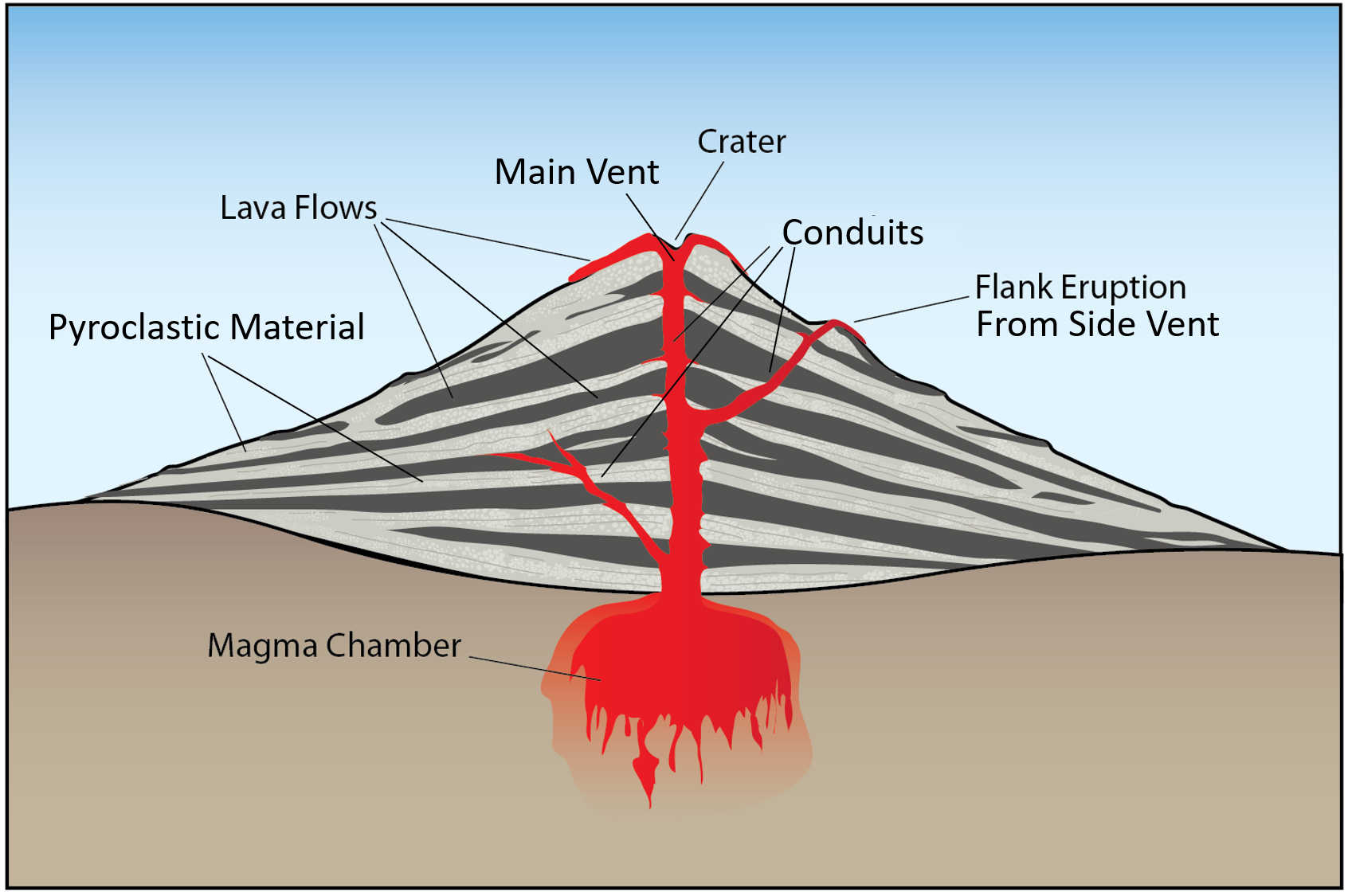
Another bowl-shaped structure that can form around the vent of a volcano is a caldera. While craters are relatively small, with diameters on the scale of 10s to 100s of meters, and are built up over time as volcanoes deposit material around the vent, calderas are much larger (km in scale) and form when a volcano collapses on itself. This process is illustrated in Figure 1C.1.3. It begins when an eruption occurs and the magma chamber beneath the volcano is drained. If a significant part of a volcano’s mass is supported by magma within the chamber, then depleting the magma chamber also reduces the support for the volcano. The loss of support causes part of the volcano to collapse into the void created by an empty magma chamber, leaving behind a broad basin rimmed by the remnants of the volcano. Over time, the basin can fill with water. If there is still activity within the magma chamber, magma may force its way upward again causing the floor of the caldera to be lifted or erupting to form a new volcano within the caldera.

The island of Santorini (Figure 1C.1.4) is an example of a caldera. The island itself is the rim of the caldera, and the bay is the flooded basin. The two small islands in the middle of the bay formed from magma refilling the chamber that feeds the volcano (Figure 1C.1.4 right). The caldera formed after an enormous eruption between 1627 and 1600 BCE. The eruption is thought to have contributed to the downfall of the Minoan civilization, and some speculate that it might also be the source of the myth of Atlantis, a story about a lost continent that sank beneath the sea after a natural disaster.
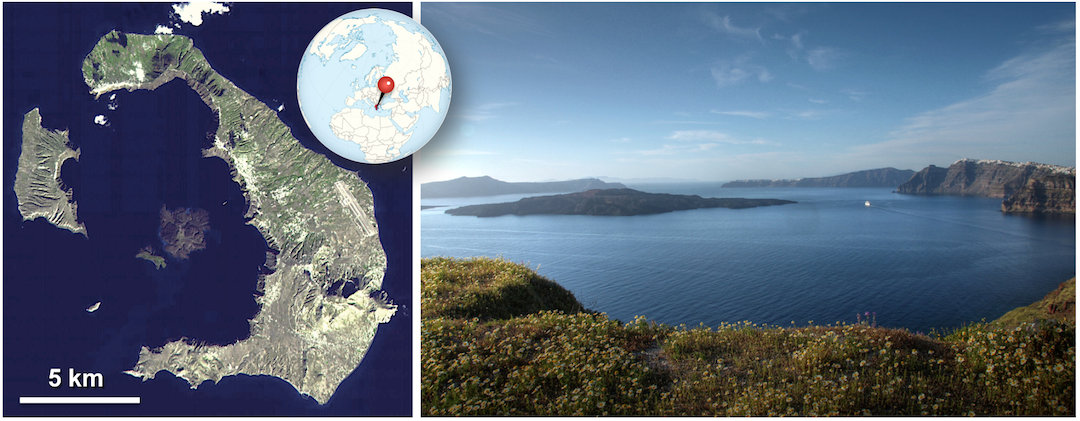
Check your understanding: Volcano Anatomy
1.2 Volcanic Explosivity
Whether a volcano erupts explosively or effusively (non-explosively) is determined by several interconnected factors:
- viscosity of the magma
- composition of the magma
- temperature of the magma
- amount of gas trapped in the magma
- addition of water to the magma
Viscosity is the resistance of a material to flow. So, materials that are highly viscous do not flow easily. They can be though of as “sticky”, like honey. Materials that have low viscosity flow easily and are fluid and runny, like water. Magma that is viscous (sticky) is far more explosive than runny magma.
Check your understanding: Viscosity
The viscosity of magma is a function of its composition and temperature. Figure 1C.1.5 below illustrates this relationship. This is the same figure showing igneous rock classification as seen back in Chapter 1A.1 (Figure 1A.1.2) on Earth’s composition and shown again when explaining partial melting in Chapter 1A.3 but with temperature and viscosity information added.
Remember that minerals do not all melt at the same temperature (this was the chocolate chip ice cream analogy), which means magmas of different mineral compositions will have different temperatures (newly melted ice cream is still pretty cold, but melted chocolate chips will be quite warm!). Three magmas important in building volcanoes are rhyolitic, andesitic, and basaltic magmas. Rhyolitic magmas are cooler than andesitic magmas, which are cooler than basaltic magmas. To connect magma temperatures to viscosity is intuitive: which flows more easily, warm honey just heated up in the microwave or cold honey just taken out of a fridge? The warm honey flows easier; it is less “sticky”/less viscous.
The relationship between viscosity and magma composition is less intuitive, although for any who like to cook, a good analogy might be that of using a roux or cornstarch to thicken a soup (or sauce, or gravy…mmm…gravy). The more roux/cornstarch added, the thicker (more viscous) the soup will be. For magma, this “thickening” agent is silica. On the igneous rock chart, working from left to right through the compositions, a felsic magma composition (rhyolite) has the most silica, and is therefore the most viscous magma, an intermediate magma composition (andesite) has slightly less silica, and a mafic magma composition (basalt) has less silica still and is therefore the least viscous (see top and bottom arrows on Figure 1C.1.5).
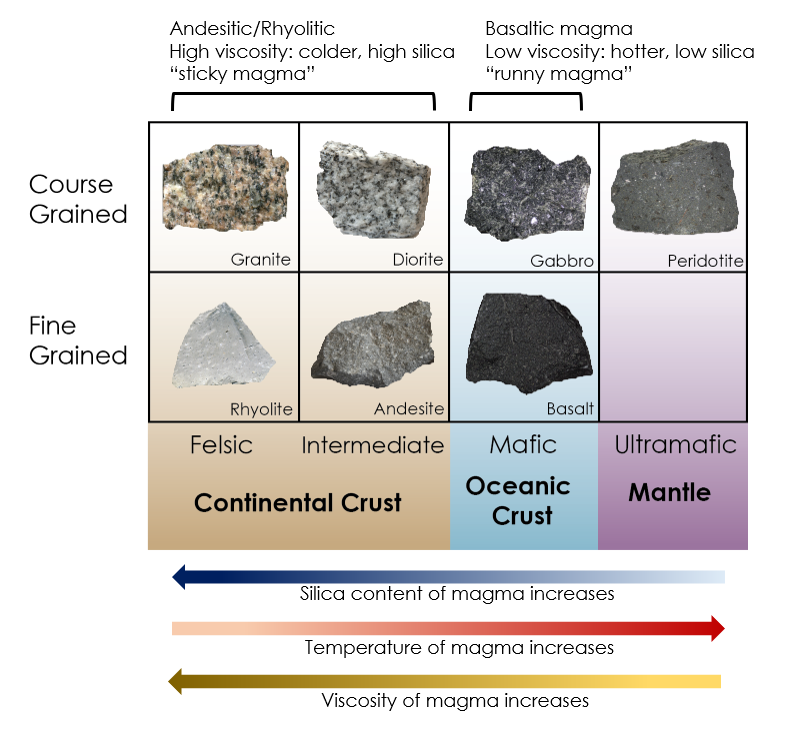
The third factor affecting explosivity of an eruption, the amount of gas trapped in a magma, can also connect to viscosity. A thicker, stickier, more viscous magma is more easily able to trap gas inside it. Magmas that have more trapped gas are more explosive than magmas where the gas can easily escape. For the final food analogy of this section, think of two bottles of pop. One was accidentally left uncapped all night and went mostly flat before it was capped again and has since been sitting on the counter – this will be the “runny” magma. The other has been tightly capped, never opened, and bouncing around in a backpack all day – this will be the “sticky” magma. (It is not a perfect analogy because in this case the pops are the same viscosity, but it works because one has more gas trapped inside than the other – which is what is needed for the analogy). Which of those two pop bottles is more likely to explode and spray your nice white shirt with pop when you try to open it? The one that is fresh and has been bouncing around all day! All of that trapped gas in the pop is going to come rushing out when the cap is removed, and the pressure gets released causing an explosion of pop. The flat pop does not have much gas left to lose so it does not explode as much. The same thing happens with volcanic eruptions; the more gas that is trapped within a magma the more likely those gases will explode out (along with the magma) once the pressure is released, which for an eruption is once the magma starts to move to the surface.
This means basaltic magmas tend to create effusive eruptions while rhyolitic and andesitic magmas make explosive eruptions.
Finally, the addition of water to a magma can alter how the volcano will erupt. The immense heat of magma will cause water to flash to steam, meaning the water instantly transforms to steam from liquid water. The outward pressure created by this rapid expansion of water molecules can turn what would have otherwise been effusive eruptions into explosive ones. This is what happened when the Island of Surtsey formed from a volcanic eruption beginning in 1963. Surtsey is located just south of Iceland along the Mid-Atlantic Ridge – volcanism in Iceland is typically effusive basaltic lava flows. However, at the start of the eruption, the top of Surtsey was underwater allowing sea water to pour into the vent and violently flash to steam upon meeting the hot magma. This resulted in more explosive columns of ash rising out of the vent as seen in Figure 1C.1.6. In total, Surtsey erupted for over three and half years and grew from an underwater volcano to a volcanic island of around one square mile. In the case of Surtsey, the source of the water was liquid sea water, however the water could be from any source from liquid water to rapidly melting glacial ice sitting atop the volcano.
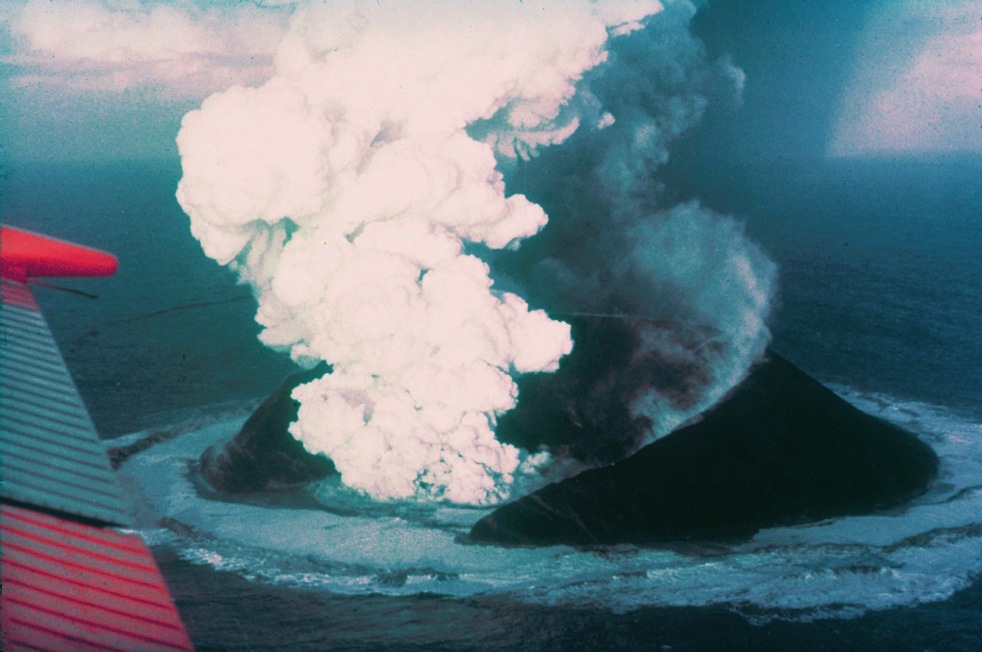
Check your understanding: magma compositions
Check your understanding: Explosivity
Drag and drop the correct labels to complete the chart below. This incorporates all of the magma elements controlling volcanic explosivity.
References
Friedrich, W. L., Kromer, B., Friedrich, M., Heinemeier, J., Pfeiffer, T., & Talamo, S. (2006). Santorini Eruption Radiocarbon Dated 1627-1600 B.C. Science (312)5773, 548. doi: 10.1126/science.1125087
